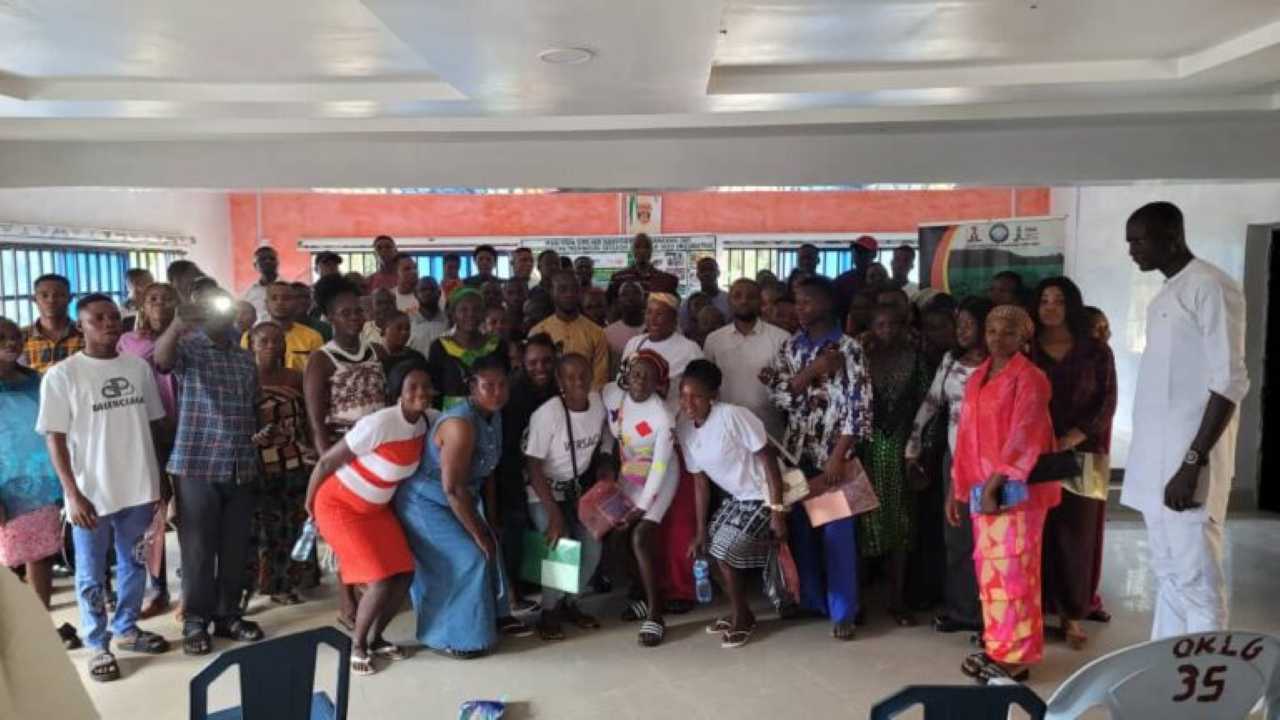
• As CBN remains adamant on boosting local production
During the 2020 Yuletide, Miss Folakemi Ojo made frantic attempts to attract buyers to a rice store where she worked as a sales attendant, but none branched at the store within Daleko Market, a popular foodstuff marketplace located off Isolo-Oshodi Expressway, Lagos.
She expressed frustration over her inability to make adequate sales, while the store was fully stocked with Nigerian rice in preparation for the festive period. The year had been full of COVID-19 pandemic-induced lockdown, #EndSARS protests and violence, partial opening of offices, mass disengagement, working from home, economic recession, and a second wave of the COVID-19 pandemic surge. Economic and purchasing power of most Nigerians had been eroded, but prices of food items were on the high side due to 14% or more inflation rate.
Asked why the prices of locally processed were that high, Miss Ojo said: “Dealers and middle men are responsible.” She explained that her boss, the owner of the store, did buy directly from a rice mill in Kano immediately land borders were closed and emphasis was placed on local rice consumption. But as the miller got a fair share of the market, it became difficult buying directly from him. The miller would only sell to middlemen, who would in turn supply to various cities and marketplaces, higher than the recommended prices. With that, prices became higher, and increasingly got out of the reach of moor Nigerians, she explained.
Another shop owner in the marketplace, Mrs Jumoke Olayiwola, lamented inability to make good sales because the prices of brands of rice were too expensive, saying: “During Christmas periods, we did sell trailer-loads of rice to companies which gave their staff. We sold to individuals who gave to the needy. Politicians did come to buy from us for their people. But this year is different. We are unable to sell. And the price is too high.”
Olayiwola blamed the Federal Government for “closing the borders, preventing rice importation and healthy competition with local rice.”
Apart from the market, surveys by The Guardian in Ibadan, Port Harcourt, Abuja and Ilorin revealed that prices of rice brands ranged from N22,000 to N26,000, which became a source of concern to Nigerians as the cost of living becomes unbearable despite efforts to promote local food production, value addition and consumption.
At Bodija Market in Ibadan, Oyo State, most local rice brands were sold at the rate of N25,000 on the average, while imported rice cost between N24,000 and N28,000, depending on the brands and long/short form of the grains.
At Oja-Oba in Ilorin, Kwara State capital, prices remained as high as N24,000 per 50kg bag for Nigerian rice and N25,000-27,000 for smuggled foreign rice during the yuletide. Even LAKE Rice, subsidised by Lagos State government and produced by Kebbi State, was as high as N20,000.
Investigations by The Guardian on why the prices of locally made rice remains uncompetitive revealed a number of avoidable and natural factors.
Low rice productivity per hectare, other issues
Productivity of Nigerian rice farmers remains very low and unsustainable as they continue to plant grains as seeds, use older and low-yielding varieties, use far less than recommended fertiliser, and struggle with weed and pest infestations.

The Food and Agricultural Organisastion (FAO) data indicates that the average fertiliser application per hectare in Africa, and by extension Nigeria, is about five kilogramme, while the minimum benchmark is 50 kilogramme per hectrare. Overuse of land and non-application of land-boosting inputs such as compost manure or inorganic fertiliser have limited yields of most farmers to about two to three tonnes of rice paddies per hectare. Also, low quantity and quality insecticides, herbicides and other agro-chemicals have resulted in poor harvests yearly. These have affected profitability, sustainability and competitiveness of made-in-Nigeria rice.
Similarly, manual farm operations and poor land preparation have hampered production and productivity of rice farmers, hence the high prices of the local brands.
Buttressing hindrances faced by farmers, Dr Olabisi Awoniyi, Assistant Director, Commercial Agriculture, Lower Niger River Basin Authority, Ilorin, said though more and more people were going into rice production, which should directly or indirectly reduce prices in the market, what was obtainable was the reverse. He added that farmers were limited in production by many reasons.
“This could account for the anomaly. Cost of procuring inputs such as fertiliser, herbicides and insecticides have skyrocketed in the recent times because of the exchange rate to the dollar. Other costs of seeds and land preparation are also on the high side,” Awoniyi explained.
A rice processor in Lokoja, Kogi State, Oladejo Afiz, said: “Cost would remain high because of high demand, low production and hoarding. However, with the new opening of borders, more smuggling of imported rice would rise and create doom for a lot of farmers, particularly those spending so much on dry season farming.”
Other rice production challenges include processing hurdles, such as expensive power using generators, inefficient machines, transportation challenges following high fuel pump price, bad roads, and activities of middlemen.
A lecturer at Lead City University, Ibadan, Oyo State and rice processor, Dr Nike Olagunju, lamented that processing and delivery logistics from destinations were factors causing high price of local rice
“We should also understand that there are some cabals in the importation of foreign rice. They are our senators, house of representatives, wives, cousins, nieces and so on. They will also help in causing trouble where there is none, just to frustrate the efforts of the government at making things work so that importation can become inevitable,” she explained.
A rice breeder and Regional Coordinator, Africa Rice Centre, Ibadan, Dr Francis Nwilene, synchronised the factors as “interference of greedy rice dealers who want to reap where they have not sown; epileptic power supply for food processing and storage; activities of middlemen in distribution of farming equipment, such as tractors for land clearing, plowing, harrowing; activities of the middlemen in distribution of production inputs such as fertiliser, herbicides; and high interest rates for farming loans in Nigeria than in Vietnam, Thailand and India.”
From agro-economic point of view, President of All Farmers Association of Nigeria (AFAN), Mr Kabir Ibrahim, said: “There is inflation at 14.8% on all items in Nigeria. So, rice will be no exception.”
He, however, said availability of rice was exaggerated in the country, so the law of economics applies. “There is high demand,” he added, “and there is some scarcity. Therefore, costs will rise naturally. We must also factor the depreciation of our currency from about N360 before the COVID-19 pandemic to about N475 now.”
Climate change and insecurity of farmers
Other factors that have contributed to shortage of production of rice and high prices of various brands are insecurity and negative effects of climate change.
Boko Haram terrorists, bandits and herders have been killing, maiming and displacing farmers, and over 75,000 farming households cultivating thousands of hectares of land have been displaced in the north-eastern and north-western Nigeria. They currently occupy various internally displaced people’s camp. A majority of the farmers did cultivate rice, which they could no longer do since displacement.
Over 70 rice farmers were killed in Borno State while harvesting their rice, while the Federal Government, through a presidential spokesperson, Shehu Garba, blamed the farmers did not get a military clearance to harvest their rice.
Awoniyi said: “Recently, some rice farmers were slaughtered in their farms, creating panic among farmers. Banditry, kidnapping and terrorism have reduced farmers’ access to their farms. Farmers can only produce rice if they are alive. These, all put together, have drastically reduced production in Nigeria, hence, supply is lesser than demand.”
He added that many rice farms were destroyed by cattle herders in many parts of the country, “hence there was reduction in the tonnage that could been available to the market.”
The general insecurity across the country has, food experts said, depleted the volume of rice and other food crops produced in the country, accounting for high prices of foodstuffs, including rice.
Also, elongated dry spells in the southern, and devastating floods in the northern parts of the country in 2020 dealt a devastating blow on the ability of the country to produce enough food through the rain-fed system of agriculture.
The 2020 Seasonal Rainfall Prediction (SRP) of NiMet early in the year predicted that “Severe dry spell that may last 10 to 18 days is predicted over Niger, Bauchi, Jigawa, Sokoto, Zamfara, Katsina, Kano, Kebbi, Yobe and Borno in the month of June.
“In the year 2020, severe effect of little dry season is expected over the coast of Lagos, Ijebu-Ode, Ibadan, Akure, Shaki, Iseyin, Ilorin, and Ado Ekiti.”
The length of days with relatively dry spells, the agency added, was expected to last between 10 and 25 days in places like Abeokuta, Osogbo, Shaki, Iseyin and Ilorin, with more than 50% chance of occurrence, while the coast of Lagos, Ikeja, Ibadan, Ijebu-Ode and Akure could have dry spells above 30 consecutive days in a worst case scenario.
More than the forecast, rainfalls stopped for approximately two months, covering states in more than three geo-political zones of the federation, making crops to stunt and perish, while farmers wallowed in losses.
Farm flooding was reported in Taraba, Kebbi and Benue states, where grains were submerged, flushed away, and in some cases, lives were lost. Flooding displaced more than 15,000 people Kaduna, Katsina, Sokoto, Kebbi, Benue, Taraba and Zamfara states.

CBN/FG interventions
The Anchor Borrowers’ Programme (ABP) of the Federal Government was launched in November 2015. The purpose of the scheme is to create a linkage between companies involved in the process of selecting key agricultural commodities and small holder farmers. The focus of ABP is to provide seed to farmers and cash to grow the crops, and it is expected that this would boost production of the selected commodities and make sure there is constant supply of the commodities to the agro processors.
The programme targets farmers who produce cereals such as rice, maize and wheat; roots and tubers such as cassava, potatoes, yam and ginger; tree crops like oil palm, cocoa and rubber; legumes such as soybean, sesame seed and cowpea; livestock such as fish, poultry and ruminants. Also included are cotton, sugarcane and tomato.
The participating banks, which work with the Central Bank of Nigeria (CBN), lend to anchors at 9% per annum for onward disbursement to the farmers. The loan is repaid by the farmers after the crops have been harvested with the harvested crops which must cover the loan principal and interest.
Rice farmers and millers
Due to the efforts to reduce the foreign exchange food importation yearly, the first crop that has received greater emphasis and has incorporated as many farmers as possible is rice. Loans, improved rice seeds, fertilizer, agrochemicals and other inputs are facilitated to rice farmers, and the Nigeria Incentive-Based Risk-Sharing System for Agricultural Lending (NIRSAL) de-risks the facilities.
It is estimated that over N240 billion ‘revolving’ credit facilities have been granted to small-scale farmers and processors in the Federal Government’s ABP.
President of the Maize Association of Nigeria (MAAN), Dr Bello Abubakar-Annur, disclosed to The Guardian that his members participated in the 2019 ABP credit facilities for the first time. And about N5.4 billion was advanced to the farmers under MAAN.
Kebbi State chairman of the Rice Farmers’ Association (RIFAN), Mr Augie Sahabi, said each member got N250,000 worth of inputs, including seeds, fertiliser and agrochemicals in the off-taking arrangements in 2020.
About 78,000 farmers are said to be members of the association who are involved in the ABP scheme in the state. By implication, over N19.5 billion was advanced to farmers in the state.
The CBN Governor Godwin Emefiele had told the Senate Committee on Banking, Insurance and other Financial Institutions in May 2019, when he was screened for the second term re-appointment, that over N190 billion had been disbursed to about 1.1 million farmers holding fewer than five hectares each.
Despite the efforts, local rice has remained more expensive than imported brands, and experts attributed the higher price to greater demand over supply of local rice, especially when the borders were closed and smuggling was minimised.
Other factors include higher cost of production emanating from more expensive land preparation, higher cost of power, and high level of insecurity across the food production belts, as well as natural encumbrances amid low insurance coverage of agricultural investments and farms.






